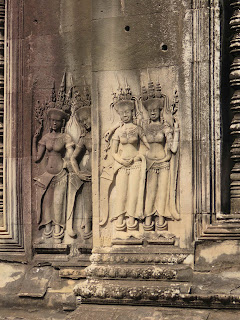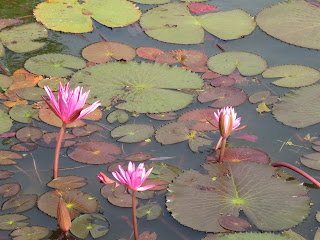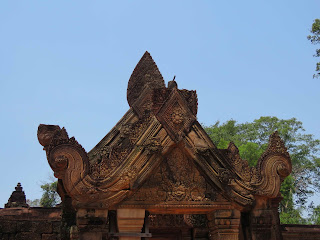Fortunately our overland tour didn't leave for the airport
until 1:30 in the afternoon, so we had the morning to make sure we hadn't
overpacked for it! Two nights and one touring day meant that we could fit everything
into one of the original Crystal duffel bags that Monica and her Mom had bought
years before, and that still fit size- and weight-wise within carry-on
restrictions, including bathing suits! Unfortunately a lot of people didn't
pack as lightly and once we arrived at Siem Reap, we had to wait for the
checked bags before the buses could leave for the hotel. As it turned out, we
had about 60 people on the tour so it made getting there a little difficult.
Most of us were on one flight, and the remainder on a slightly later one.
We stayed at the Sokha Angkor Resort in the town of Siem
Reap. The hotel is very nice and comfortable, and only a few kilometres from
the temples of Angkor Wat. Again, we were surprised at the number of hotels and
resorts, including some of the big international names like Sofitel and Park
Hyatt. Rather than remaining the small backwoods hamlet that only intrepid
travelers would venture to, in the past 20 years Siem Reap has become a
bustling town built almost entirely around tourism at the temples.
 |
| Our hotel room. Not huge, but comfortable for a couple of nights. |
 |
| The view from our balcony |
We were starting out early the next day and would have a
full day ahead of us with visits to four different sites and lunch at another
hotel. On the buses by 7:45 was the instruction, and, lo and behold, there we
all were, on time!
First stop, Angkor Wat, the site of the temple and mausoleum
for King Suryavarman II in the 12th Century. It was constructed as a religious
monument to the god Vishnu and meant to be the largest temple in the world.
According to our research, the moat, which is prominent in a few photos here,
is 190 metres wide, and 1.5 km wide by 1.3 km long! The article observes that
it makes the moat around the Tower of London, built around the same time, 'look
like a garden trench'.
 |
| Entrance gateway |
 |
| The portico on the right protects the 'story wall' where the devotion to Vishnu and the king's military prowess were carved for all to marvel. |
 |
| A small section of the carving. Parts of it are shiny now because people had rubbed their fingers on the horses. Now no one is allowed to touch it. |
 |
| We didn't see much wildlife, but this monkey stayed long enough to get into a photo. |
 |
| The interior side of the entrance wall. Figures of 1,000 apsara dancers were said to have been carved on this side. |
 |
| Intricate carving is still visible on the sandstone. |
 |
| Buddhist monks still worship here at some of the statues to Buddha. |
 |
| More carving. |
 |
| Part of the main temple building |
 |
| Examples of the apsara dancers |
 |
| Part of the main temple complex. It was too big to get a good photo including the high central temple. |
 |
| The moat. The original bridge is undergoing some renovation so tourists cross it on this floating bridge. |
 |
| Lotus flowers in the moat |
 |
| Some of the ornamental carving at the end of the original bridge. |
As you can see from the photos, there were lots of people
around, and even though it became hotter and more humid as the morning
progressed, it didn't stop the visitors from coming. By the time we met back at
the buses, we were all ready for a respite in air conditioned comfort, although
there had been an unexpected breeze blowing through the open areas. We still
had a stop before lunch, though, and headed out to Banteay Srei.
Banteay Srei is another ruined temple that actually
pre-dates Angkor Wat by a couple of hundred years, built in the late 900s by a wealthy adviser to the Khmer king. It
is quite small in comparison, but the carving on the stone is very ornate and
the figures are very clear. The sandstone here has a beautiful reddish colour,
so Banteay Srei has also been called the 'Pink Temple'.
Time for another break! The hotel where we were having lunch
was located closer to Angkor Thom, the main city of the Khmer ruler to
accompany the temple complex of Angkor Wat. The drive again showed us how much
of the population lives in the rural areas as farmers, mainly growing rice.
Most of the rice that is exported through Thailand is actually grown in
Cambodia and Vietnam, but those countries don't have the processing facilities
so the raw harvest is sent there. The real surprise is just how much one
hectare of land can yield - depending on the conditions and rice type, a farmer can get
multiple harvests in a year, averaging about 3 tons per hectare over two harvests.
 |
| Rice plants |
 |
| Cattle roam freely and are not raised for meat, as Cambodia is primarily Buddhist. Farmers keep buffalo to help them in the shallow rice paddies and the fields. |
 |
| A couple of houses. Many are built on stilts to keep the living area dry in monsoon season, as flooding can happen almost any time. |
 |
| The local marketplace |
Like Angkor Wat, Angkor Thom is surrounded entirely by an 8
metre high wall that runs three kilometres square as well as a moat almost as
wide as the one at Angkor Wat. The city can only be reached by crossing bridges
that lead through four gates in the wall, one in each direction, and they are
all guarded by statues of gods on one side of the bridge and demons on the
other - 54 of each. Why 54? Because 9 was a sacred number to the Khmer, and
that had to be the result when the digits of a number were added up. So 5+4=9,
54x2=108, 1+0+8=9, etc., and any multiples of 54 will work the same way. We
hate to break it to the Khmer after they did all that work, but they would get
the same result using 9, or 18, or 27, or 36, so they could have saved a lot of
time and effort on carving statues if they'd really done the math! But at least
they left us some interesting figures to look at:
 |
| Demons |
 |
| He seems rather upset that his nose is missing! |
 |
| A god |
The four entrance gates are all crowned with a large, serene
face looking in each direction. Some scholars say these are supposed to be gods
like Vishnu or Buddha, and some say they are just the face of the king, who saw
himself as part god anyway. We may never know for sure.
As with Angkor Wat, the story of how the Khmer defeated
their enemies is depicted on a carved wall.
Because we had transferred from our standard buses to small
touring coaches, we were driven to the main temple ruins - good thing, because
many of us wouldn't have gotten half-way had we had to walk! The humidity was
getting to us all by this time, and some people had actually abandoned the tour
in favour of relaxing at the hotel spa. They had come to see Angkor Wat, and
after that everything was YAT - yet another temple!
Angkor Thom's main temple, the Bayon, is dedicated to
Buddha, but no one is sure if the 216 (numbers again!!) serene faces carved
around the temple are supposed to depict Buddha or the Khmer king Jayavarman VII
who built it.
Our final stop for the day was in the same complex but at a
different temple, Ta Prohm. This one is famous because of the way it was ruined
- by trees. Other temples both here and in Vietnam were being slowly ruined by
small vegetation breaking down the stone in tiny crevices, but the extent of
the destruction at Ta Prohm looked as though someone had come in with a wrecking
ball! We were getting so 'templed out' by this time that we forgot to take
pictures of the piles of stones in the courtyard.
Of course the real claim to fame here for most tourists is
that the temple was used in the Angelina Jolie movie, 'Tomb Raiders',
particularly a doorway with a massive tree growing on the wall beside it.
 |
| The 'Tomb Raiders' tree |
Finally, after a very long and hot day we climbed in our
buses for the last time and drove back to the hotel for a bit of free time
before our special buffet dinner by the pool that would be accompanied by
traditional music and dance, as well as apsara dancing. But first, those of us
who had packed bathing suits were in the pool within half an hour of getting
back. Enough time for a refreshing swim before getting ready for the evening.
It was lovely!!!
 |
| The pool area decorated for our dinner and show |
Apsara is a special dance which must be related to the gods
because almost every temple we saw had many, many carvings of dancers - in fact
the interior side of the main gate to Angkor Wat was said to have been
decorated with 1,000 Apsara dancer figures. You may not recognize the name, but
the slow, deliberate movements, ornate headdresses and especially the almost
double-jointed movements of the dancers' hands will very likely be familiar to
you.
Our flight down to Sihanoukville, Cambodia to meet the ship
was earlier than originally planned, so we didn't have any time to relax in the
morning. Once we arrived and collected the bags, we were driven out to another
Sokha hotel, the Sokha Beach Resort, for lunch and a little down time before we
complete our tour at the Wat Krom Temple. Yes, we know, ANOTHER temple?? But this
is an actual working temple and Buddhist monks get some training here.
First, the Sokha Beach Resort. The beach here is very long and sandy, and makes Sihanoukville the prime beach destination in the country.
Now to Wat Krom:
 |
| Outside one of the temples. The small temples behind are the cemetery |
 |
| Buddhist monk statues. Part of the monks' service is to provide prayers to the people in return for food. People believe that providing food to the monks will bring them good luck. A win-win situation. |
 |
| Reclining Buddha. Lying on the right side means he has gone to Nirvana, on the left means he is sleeping. |
 |
 |
| Inside the main temple |
 |
| Carving on the roof of the temple |
Our guide must have realized that we were all getting hot
and sweaty and tired because he shortened the tour to get us back on the bus
and to the ship.
It was a great tour, and gave us the opportunity, however
brief, to see some of these not-so-ancient but very important sites in
Cambodia, as well as get an impression of how the people are living and the
economy is growing. Cambodia is about 20 years behind Vietnam but it will catch
up sooner than we think. The building boom in Sihanoukville alone is geared to
casino hotels on the beach and will bring huge tourist dollars to the country.
As well, there is some talk of Cambodia having undersea oil reserves that will help
fund its economic growth. We'll see what happens next. As one of our guides
said, one day we will be able to go back and say, 'I knew Cambodia when....'.


















































No comments:
Post a Comment